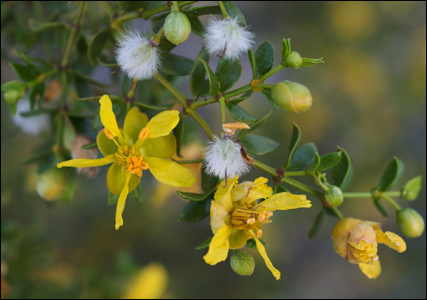Uses and Health Benefits of Creosote Bush (Larrea tridentata)

Introduction
Larrea Tridentata is a group of closely related wild shrubs. It has a number of other common names. As a plant known as "creosote bush" and "greasewood", as a medicinal herb known as "chaparral" and as "gobernadora" in Mexico.
Scientific Classification
- Kingdom: Plantae
- Clade: Angiosperms
- Clade: Eudicots
- Clade: Rosids
- Order: Zygophyllales
- Family: Zygophyllaceae
- Genus: Larrea
- Species: L. tridentata
- Binomial name: Larrea tridentate
- Common Name: Chaparro, Creosote bush, Dwarf evergreen oak, Gobernadora, Greasewood
Description
It is an evergreen shrub growing to 1 to 3 m tall, rarely reach to 4 m (13 ft). The stems of the plant consist sticky, dark green leaves with two opposite lanceolate leaflets which are joined at the base, with a deciduous apex between them. Each leaflet 7 to 18 mm long and 4 to 8.5 mm thick. The flowers consist five yellow petals and grow up to 25 mm in diameter. The whole plant exhibits a unique odor of creosote (a brownish oily liquid) due to this it has a common name as Creosote bush. Its smell resembles the same as "smell of rain".
Distribution: Larrea Tridentata grows in desert regions, including those of the southwestern United States, South America, and northern Mexico.
Parts used medicinally: Leaves, flowers, and fruit.
Chemical Constituents of Larrea tridentata
Larrea tridentata contains nordihydroguaiaretic acid (NDGA), flavonoids as non-water-solubleaglycones, as water-soluble glycosides, and as sulfated flavonoids. It also contains triterpenesaponin as well as volatile oils, wax esters, sterols, and other hydrocarbons.
Medicinal Properties of Larrea tridentata
- Antibacterial
- Antifungal
- Antiparasite
- Antitumor
- Emetic
Benefits of Larrea tridentata
The main constitute of Larrea Tridentata is nordihydroguaiaretic acid (NDGA), which is medically beneficial. NDGA bears antioxidant and anticancer properties and may be useful in the treatment of various illnesses involving different systems of your body such as cardiovascular system, immune system, nervous system.
Cardiovascular Disease
Larrea Tridentata consist of antioxidant property that help to prevent disease by decreasing the free radical level in the body. It protects blood vessels and arteries from the damage caused by high cholesterol level, atherosclerosis, high blood pressure, diabetes, and other causes.
Lowers Cholesterol
The ethanolic extract of this herb reduces total cholesterol, triglycerides, insulin and enhance the sensitivity of insulin. It enhances the antioxidant capacity in the liver. This ethanolic extract of Larrea Tridentata helps to treat Multiple sclerosis (MS).
Teat Cancer
Research suggests this plant helps to treat cancer and viral diseases as it contains nordihydroguaiaretic acid (NDGA). This anticancer property, helps to treat several types of cancer including, breast, esophageal, prostate, lung, and skin cancer. It may slow down the growth of cancerous cells and tumor. It enhances some treatments and minimizes the negative side effects of chemotherapy on healthy cells.
HIV Treatment
NDGA (nordihydroguaiaretic acid) is a natural antioxidant which helps to reduce the endothelium and vasocontractility which is induced by HIV protease inhibitor ritonavir (RTV) in the porcine pulmonary arteries. NDGA restricts RTV action and inhibits superoxide anion production in Human Pulmonary Artery Endothelial Cells (HPAEC) and pulmonary arteries. This shows that the use of NDGA is useful in patients of HIV.
Neurological Disorders
Oxidative stress play a major role in neurodegenerative disease. Oxidative stress can occur from free radicals. NDGA in Larrea Tridentata is antioxidants which help to inhibit the production of oxidative stress by free radicals. It provides a potential treatment for neurological disease and also protects brain cells from various types of damage. NDGA has been recommended as a potential treatment for:
- Alzheimer's disease
- Amyotrophic lateral sclerosis (ALS)
- Parkinson's disease
- Epilepsy
- Stroke
Immune System
NDGA boosts our immune system by suppressing and inhibiting certain viruses, such as Herpes simplex virus, HIV-1 (human immunodeficiency virus), HPV (human papilloma virus), and Influenza (flu) virus.
Traditional Uses of Larrea tridentata
- The decoction preparation from dried branches and bark is used for diabetes and from dried roots used orally for abortive and diabetes.
- An extract of hot water and dried leaf is used to treats urinary tract infections, kidney problems, and frigidity, and also acts as a blood purifier.
- It is also used for the treatment of gallstones, wounds, diabetes, rheumatism, arthritis, tumors, paralysis, and skin injuries.
- The hot water extract of dried leavesis also used as an expectorant and tonic to treat tuberculosis.
- An infusion of the herb may be used to treat dandruff.
- It is also used as diuretic, venereal disease and treat bowel cramps by Indians.
- The hot water extract of dried leaf is used externally to heal wounds.
- The decoction prepared from leaves helps to cure stomach ailments and diarrhea.
- Young branches of this plant are used as a cure for toothache.
Dosage
The appropriate dose of LarreaTridentata depends on several factors such as patient's age, health, and several other conditions. So it is better to consult the doctor, pharmacist or health care provider who is familiar to this herb.
Contraindications
- It should not be recommended in patients with poor liver function and kidney function due to its increased risk of toxicity.
- It is also not used during pregnancy and lactation because it shows adverse effects on uterine activity.
Side Effects
- This herb can cause serious side effects like acute hepatitis, skin reaction, and kidney and liver damage, including kidney and liver failure.
- Other side effects are stomach pain, weight loss, nausea, diarrhea, and fever.



